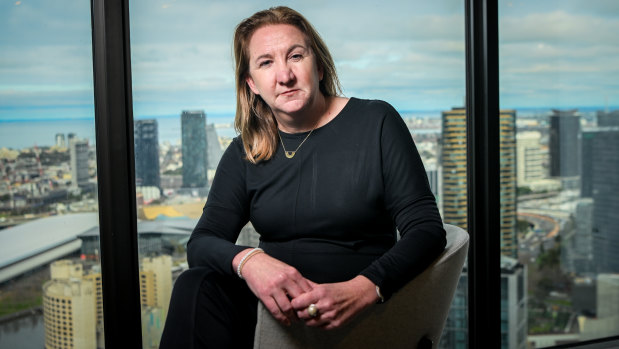How this executive is readying for a boom in financial crime reporting requirements
From her office on Collins Street one of KordaMentha’s newest partners, Rachel Waldren, is helping businesses come to grips with the increasing risk of financial crime and their growing responsibility to report suspicious money transactions to regulator, AUSTRAC.
Waldren leads the firm’s financial crime division alongside fellow partner Alice Saveneh-Murray. The experienced investigators joined KordaMentha last year after their consultancy business Murray Waldren merged with the advisory and investment group.

Rachel Waldren, partner at KordaMentha, has worked in senior anti-money laundering and financial crimes roles at NAB and ANZ.Credit: Justin McManus
The financial crime business unit helps businesses, regulators and royal commissions understand and navigate Australia’s anti-money laundering and counterterrorism rules and the risks faced by various corporate practices at banks, financial services groups and gambling houses.
It’s a business unit that is likely to dramatically increase in coming years as Australia looks to expand its anti-money laundering and counterterrorism financing laws to include real estate agents, accountants and lawyers. Attorney-General Mark Dreyfus is considering industry responses to a consultancy paper outlining how the proposed new laws, known as ‘tranche two’ will be implemented.
Waldren, who has worked in senior anti-money laundering and financial crimes roles at NAB and ANZ, says the changes are necessary as they will be extended to what are known in the anti-financial crime business as “gatekeeper” industries.
“Currently, they have limited obligations to identify their customers or to report anything suspicious. [Under the proposed rules] their job will not be to be police officers; it will be to detect and report activity that looks suspicious or unusual.
“Based on our experience, there is limited awareness in the tranche two type entities, particularly the smaller ones. Many are small or medium-sized businesses, who may not understand that they will have these obligations and they may not understand how to comply with them because the way the act and the rules are currently written is very complex.”
These groups are important because they can be used by money launderers looking to turn their ill-gotten gains through a variety of illegal activities into untraceable clean money.
“There’s professionalisation of money laundering at the moment,” says Waldren. “They [money launderers] have their own accountants, their own real estate, their own lawyers – because it’s a business. They are literally professionals, they are very sophisticated.”
With the broadening of AUSTRAC’s oversight, the workload of the regulator is expected to boom. Experts have estimated the number of groups falling under AUSTRAC’s regulation will increase from about 14,000 entities to 150,000 once real estate agents, accountants and lawyers are included in the reporting regime.
A targeted approach could be the best way Australia’s powerful, but small, AUSTRAC, could effectively oversee this massive increase in work.
“What we’ve said in our submission is that the government should think about different ways to supervise the regulated population. This would also disperse cost across the different sectors based on the amount of risk that they face.”
Organised crime groups operating in higher crime areas where there might be a greater propensity for money laundering activity could also be targeted, Waldren says.
“So what we’re saying is, don’t just apply a single standard, look at the different entity sizes, the risk of what they’re doing and where they’re doing it, and reduce the regulatory burden across the reporting entity population that way.”
KordaMentha’s submission also recommends that supervision could be aided by a network-based approach which draws on regulated groups with strong industry associations and advisory groups to educate, detect pockets of potential problems and help establish practice guides for regulated businesses.
“We’re saying think more broadly, think more smartly about how to regulate,” she said.
“Use professional advisory firms, as an example, use industry bodies such as the Regtech Association, and others like Blockchain Australia to help push out that message to their members.”
As well as helping newly regulated real estate agents, accountants and lawyers, a network regulatory model could help financial services groups that are already required to report suspicious transactions to AUSTRAC, including cryptocurrency groups and smaller financial groups.
Smaller businesses, such as suburban accountants or small real estate agencies, will also need a regulatory model that ensures that they are helped rather than just punished. This could be done by allowing banks to share the result of their own checks and balances on a customer with a third party involved in a transaction, like a real estate agent.
“There really needs to be a better way for smaller entities with less risk to facilitate their compliance,” Waldren said.
“That might be a technology platform, similar to [online conveyancing portal] PEXA, where people can opt in and share or grant permission access to KYC [know your customer] that’s been collected and verified by someone else.”
The Business Briefing newsletter delivers major stories, exclusive coverage and expert opinion. Sign up to get it every weekday morning.